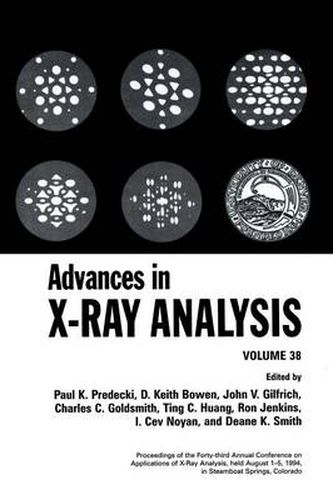Readings Newsletter
Become a Readings Member to make your shopping experience even easier.
Sign in or sign up for free!
You’re not far away from qualifying for FREE standard shipping within Australia
You’ve qualified for FREE standard shipping within Australia
The cart is loading…






This title is printed to order. This book may have been self-published. If so, we cannot guarantee the quality of the content. In the main most books will have gone through the editing process however some may not. We therefore suggest that you be aware of this before ordering this book. If in doubt check either the author or publisher’s details as we are unable to accept any returns unless they are faulty. Please contact us if you have any questions.
The 43rd Annual Conference on Applications ofX-ray Analysis was held August 1-5, 1994, at the Sheraton Steamboat Resort & Conference Center in Steamboat Springs, Colorado. The Denver X-Ray Conference has evolved from the 1950’s into an international forum for the interaction of scientists, engineers and technologists interested in the use of x-rays in materials characterization. It has not only acted as a venue but has both stimulated and nurtured many of the principal developments in this field over the years. The major changes that have been occurring on the national and international scene as a result of the end of the cold war have dramatic-ally affected the way the materials community does business. The removal of defense priorities and development funds from most new materials initiatives has stimulated the char acterization communities to look to increasing the speed of their methods. This is being accom plished via the development of very fast dynamic characterization procedures which can rapidly and intelligently monitor and optimize the formation of a desired microstructure. The develop ment of intelligent characterization procedures applied in real-time during the manufacturing process can lead to the ability to design desired microstructures. Another potential advantage to this approach is its ability to characterize the actual amount of material which goes into a final product; permitting a rapid transition from R&D to manufacturing by avoiding the prob lems associated with scale-up.
$9.00 standard shipping within Australia
FREE standard shipping within Australia for orders over $100.00
Express & International shipping calculated at checkout
This title is printed to order. This book may have been self-published. If so, we cannot guarantee the quality of the content. In the main most books will have gone through the editing process however some may not. We therefore suggest that you be aware of this before ordering this book. If in doubt check either the author or publisher’s details as we are unable to accept any returns unless they are faulty. Please contact us if you have any questions.
The 43rd Annual Conference on Applications ofX-ray Analysis was held August 1-5, 1994, at the Sheraton Steamboat Resort & Conference Center in Steamboat Springs, Colorado. The Denver X-Ray Conference has evolved from the 1950’s into an international forum for the interaction of scientists, engineers and technologists interested in the use of x-rays in materials characterization. It has not only acted as a venue but has both stimulated and nurtured many of the principal developments in this field over the years. The major changes that have been occurring on the national and international scene as a result of the end of the cold war have dramatic-ally affected the way the materials community does business. The removal of defense priorities and development funds from most new materials initiatives has stimulated the char acterization communities to look to increasing the speed of their methods. This is being accom plished via the development of very fast dynamic characterization procedures which can rapidly and intelligently monitor and optimize the formation of a desired microstructure. The develop ment of intelligent characterization procedures applied in real-time during the manufacturing process can lead to the ability to design desired microstructures. Another potential advantage to this approach is its ability to characterize the actual amount of material which goes into a final product; permitting a rapid transition from R&D to manufacturing by avoiding the prob lems associated with scale-up.